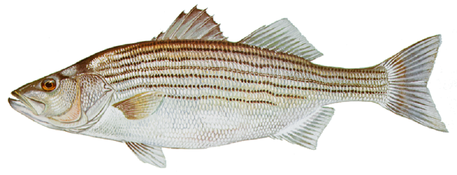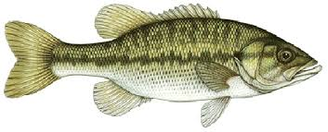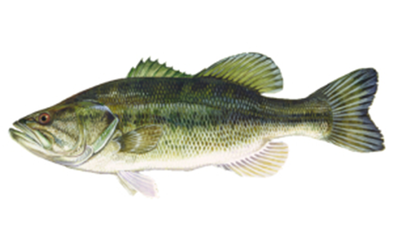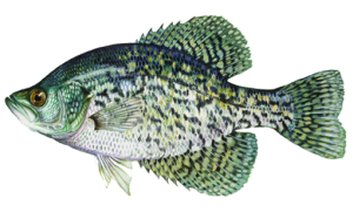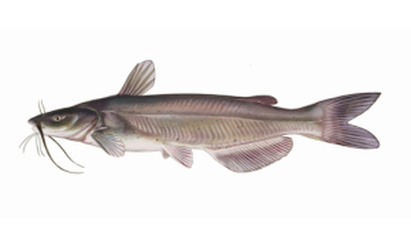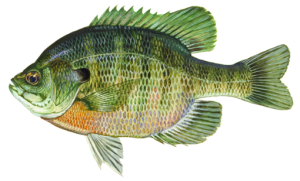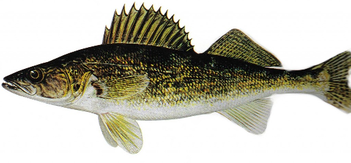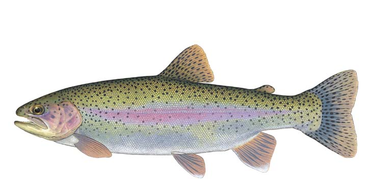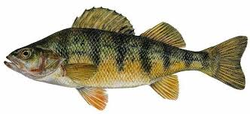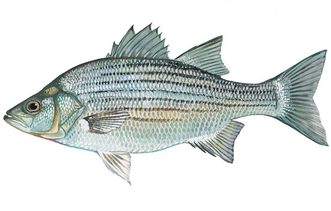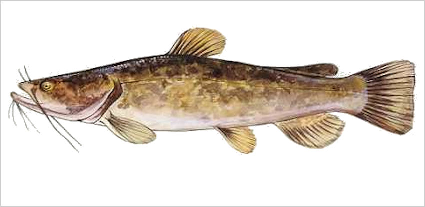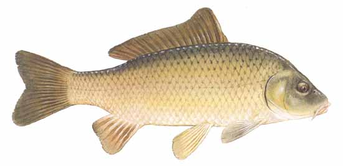Lake Lanier Fishing
Lake Lanier boasts over 38,000 acres of the best Striped and Spotted Bass fishing in the country. If you have never caught a Spotted Bass you are in for one of the hardest fights pound for pound that exist. Lake Lanier’s Striped Bass record is a massive 47 pounds. The lake record Large Mouth bass is over 17 pounds. If you just want to entertain your kids catching Bream with a small hook and worms, or catch a new state record Bass you are in luck if you visit Lake Lanier. To increase your odds of catching that record fish, call one of Lake Lanier’s professional guides. Take your kids or clients out and show them the time of their life.
Fish You Can Catch
Striped Bass
The striped bass is a large open water predatory fish that can often be found in schools. These fish are anadramous and spend most of their life in salt water. During the spawning season they travel far up rivers to spawn. Some of these fish became landlocked due to the damming of rivers, which resulted in them becoming completely freshwater. Their success in the freshwater environment has led to their stocking in many impoundments across the country. Stripers are strong fish and are known for their fighting ability and are a favorite game fish for many. Striped bass are large fish that can reach a maximum length of 79 inches and weigh more than 50 lbs. The Georgia state record striped bass is 63 lbs; Lake Lanier’s record is currently 47 lbs. They have anywhere from 6-9 dark gray unbroken stripes on silvery white sides, which is distinctive from its relative the white bass that has broken stripes. The dorsal fins are completely separate, and it has 3 anal spines with the second noticeably shorter than the third. The fins are usually clear to gray-green, but large adults have a white pelvic fin and the anal fin has a white edge. Where you will find these fish in Lake Lanier will depend on a few factors. One is the food source. One of the main preys of these fish is the shad species that are found in the lake. If you locate a school of shad it is likely that larger predatory fish will be nearby. Another factor is the water temperature. In very cold water they will stay a little deeper where the temperature will fluctuate less. As the water warms into the mid fifties through the seventies they can be caught in shallower areas and on the surface. In late summer when the water temp reaches its highest level the fish will stay deep usually just above the thermocline, which is about 35 feet deep. A variation on the summer pattern will be on overcast days, early morning, or late evening when they may be found in shallower water. These fish do not generally relate to structure so the best key is finding the food source. Lures should be chosen that imitate shad or other baitfish such as; crankbaits, large spinners, bucktails, large topwaters, and large 6” to 8” stickbaits. These baits then need to be chosen for the specific situation and depth that the fish are holding at.
Spotted Bass
The spotted bass is a species that is often confused by anglers with its larger cousin the largemouth bass. Although the fish are similar in appearance and nature their choice of habitat separates the species. Where largemouth are structure-oriented fish, spotted bass do not generally rely on cover. They will often hold in areas that have some sort of definition, like larger rocks or dropoffs, but they normally do not use the cover like a largemouth would. They also will inhabit much deeper water than most largemouths. Another difference between the spotted and the largemouth bass is their size. Spotted bass are considerably smaller, reaching a maximum of about 24 inches in length. The Georgia state record spotted bass came from Lake Lanier and weighed 8 lbs. 5 oz, but the average will be just a couple of pounds. The coloration of spotted bass s is very similar to that of the largemouth. The most noticeable difference is the addition of rows of black spots on the lower half of the side of the body. Factors such as the water clarity and depth that the fish has been living in can affect coloration making this a harder identification tool. The mouth of the spotted bass extends beyond the middle of the eye but not beyond the eye like the largemouth’s. The easiest characteristics to distinguish between the largemouth and the spotted bass are the size of the mouth and the appearance of the dorsal fin. The spotted bass has a dorsal fin that is clearly connected, while the largemouth appears to have two separate fins. Spotted bass are more abundant on the lower portions of Lake Lanier. You can find them along rocky banks, drop-offs, and humps in the lake. Lure choices will be similar to that of a largemouth, but you may need to downsize your lures and be prepared to fish a little deeper.
Largemouth Bass
The largemouth bass is probably the most sought after game fish in the country. They are known for their aggressiveness and their willingness to eat most anything. These fish are ambush predators and will generally relate to some sort of structure (stumps, logs, vegetation, docks, and other debris) where it will lie in wait for an easy meal to pass nearby. There are exceptions to this, as some times they will hold in open water, especially in impoundments, where there is abundant shad or other open water baitfish populations. The largemouth bass is a large fish that can reach up to 38 inches and weigh over 20 pounds. The world record largemouth was caught right here in Georgia and weighed 22 lbs. 4 oz. Lake Lanier’s record is 17lbs. 9 oz. The most prominent characteristic of this fish is the feature that it is named for, a large mouth. The mouth is very large and when closed the upper jaw extends well behind the eyes. They have a silver to brassy green back with mottled dark olive sides. There is also a large black stripe that is usually broken running from tail to snout. The underside of the fish is white with scattered black spots coming up the lower half. This fish is often confused with its cousin the spotted bass. The easiest ways to tell the difference is by the size of the mouth and the appearance of the dorsal fin. The largemouth’s dorsal fin is nearly separate and it appears to have two fins, while the spotted bass’s dorsal fin is clearly connected. The mouth if the largemouth is also considerably larger than the spotted bass. The best area in Lake Lanier to find these fish is in the upper end of the lake. The lower portions of the lake have limited cover, which is not the best situation for a structure-oriented fish. Some can still be found on the lower end around boat docks and some isolated cover, but most of your catch will be spotted bass. This changes as you head up into the upper creek and river channels were there is more shoreline structure. Look for fallen trees and stumps as well as rocky dropoffs and overhanging banks. You should fish these areas with a variety of lures until you find what the fish are wanting. Good choices for largemouth are spinners, crankbaits and rat-l-traps, jig and pigs, stickbaits, topwaters, most any soft plastic lures, as well as live bait such as shad and golden shiners.
Black Crappie
This fish is a favorite to many because of the quality of the meat. They are commonly called papermouths because of the thinness of the skin surrounding the mouth, and its easiness to tear. The species has been so widely introduced into reservoirs and ponds across the country that it is hard to determine where the native range originally was. Crappies grow larger than a lot of other sunfish species attaining a length near 20 inches. The Georgia state record is 4lbs. 4oz. and the Lake Lanier record stands at 3lbs. 4oz. This fish has a distinctive shape unlike most other sunfish. They have a high back with 7 to 8 spines on the dorsal fin with the soft rays of the dorsal fin rounded and extending above the spines. They have a large mouth that has very thin skin surrounding it. The coloration of the species can vary considerably. Some of the fish will be black on the back with mottled irregular black spots going down the sides over gold to silver belly. Others will be mostly silver with irregular black spots. Because of the light coloration that this fish can have it is often confused with white crappie, which are similar in appearance but have their spots arranged in vertical bars. Crappies like clear water usually around timber, brush piles, or vegetation all of which is lacking in most of the lake. Look for brush piles that have been placed around docks or in coves. Treetops from fallen trees are also make good cover for crappies. Live minnows, minnow imitating lures, and small jigs are the best choice for this species. With a compressed body, small head and arched back, the black crappie is silvery-green to yellowish, with large dorsal and anal fins of almost identical shape and size. It has a large mouth with an upper jaw extending under the eye. It has many dark spots on its sides and fins, which become more mottled toward the back. To differentiate between a black crappie and a white crappie, count the dorsal spines. The black crappie has seven to eight dorsal spines, while the white crappie has only five to six.
Channel Catfish
The channel catfish is probably the most well-known catfish species in the country. The abundance of the species and the quality of the meat make it a favorite for many. The channel catfish can be quite large reaching a length of 50 inches and weighing more than 40 lbs. The Georgia state record weighed 44lbs. 12 oz. The channel catfish is light in color ranging from a blue-gray to an olive on the back and sides. They have scattered black spots across the back and sides, which are absent in very young and large adults. The abdomen is white with abdominal pelvic fins. The fins are similar in color to the adjacent body color and they have white to dusky chin barbels. They also have well-rounded anal fins and deeply forked caudal fins. The preferred habitat is deep pools and runs over sand or rocks in small to large rivers and lakes. They can be found in most areas of Lake Lanier. Due to their highly specialized feeding nature bait should be used that has a strong odor. Good choices would be liver (beef or chicken), blood bait, cheese or dough balls, nightcrawlers, cut bait, and shrimp. This is not the only bait that catfish will eat; in some areas people will even use things like hotdogs. It is also entirely possible to catch them on minnow imitating lures but this does not happen too often.
Bluegill
The bluegill is a very common fish in many bodies of water across the country. They are a favorite for many panfish anglers because of its willingness to eat most offerings, its taste, and its fighting ability. They can be found in a variety of environments from streams and rivers to small ponds and large impoundments. Bluegills are a smaller member of the sunfish family that rarely reaches over 1lb and 16 inches in length. Occasionally they will reach a couple of pounds. The Georgia state record weighed 3lbs. 5oz. These fish have a deep, extremely compressed body with a small mouth and a body that slopes up sharply behind the head. The coloration is an olive green back with dark vertical bars running down the sides. The sides are mixed with yellow and green specks. The lower sides and stomach are yellow with orange on the chest. The bottom edge of the jaw and gill cover has a blue to purple coloration. The pectoral fin on these fish is long and pointed and they have thoracic pelvic fins. The breeding male of the species is considerably brighter than the female. This fish can be found in most areas around the lake. They can be found on open banks, but usually will be in areas that have some sort of structure. The best lure choice is small live bait such as worms, crickets, maggots, mealworms, and other small invertebrates. They can also be caught on small artificial lures. Inline spinners, jigs, and small crankbaits are a good choice. Remember these fish have a small mouth so choose your lures accordingly.
Walleye
Successful anglers are targeting the spring migration of walleye up the Chattahoochee and Chestatee Rivers. From February through April, walleye can be caught upstream of Lula Bridge (Chattahoochee) and Lumpkin County Park (Chestatee) using a variety of lures and baits. Traditional walleye anglers prefer to slow troll live nightcrawlers through the deeper holes in the river during the day or toss nightcrawlers, jigs, or a floating stick bait into the shallows upstream of river shoals. Once the spawning season is over, walleye return to the main lake. In April and early May, post-spawn walleye will be found in the upper reaches of the main lake feeding on spottail shiners along red clay points. During the remainder of the year, walleye redistribute into the lower lake and will be found close to the bottom around brushpiles and trees between 20 to 40-ft deep. Herring, nightcrawlers and jigs tipped with shiners are preferred baits in this situation.
The upper reaches of the Chattahoochee and Chestatee Rivers are the prime locations to fish for walleye in Lake Lanier between February and April. In April and May, target windblown red clay points to find walleye that are feeding on spottail shiners. For the remainder of the year, walleye can be caught with live baits fished on a 30 to 40 ft bottom that contains structure.
The upper reaches of the Chattahoochee and Chestatee Rivers are the prime locations to fish for walleye in Lake Lanier between February and April. In April and May, target windblown red clay points to find walleye that are feeding on spottail shiners. For the remainder of the year, walleye can be caught with live baits fished on a 30 to 40 ft bottom that contains structure.
Rainbow Trout
Rainbow trout are readily available in the tail waters below Buford Dam. Occasionally they are caught in Lake Lanier, but are more widespread and less common that the mountain lakes and rivers. Veteran trout fishermen will tell you to cast upstream so that your lure is always working downstream at about the same speed (or slightly slower) as the water flow. Trout are going to be facing upstream looking for their meals as it comes by on the current. They are going to be wary of anything moving against the flow and you will spook a lot of fish if you try wading and fishing downstream. If you are using live bait, there are several good ones to choose from. Night crawlers, wax worms, minnows, red wigglers and salmon eggs are among the top choices. Make sure you have enough lead to keep your bait close to the bottom but not so much that the bait drags along very slowly. You will present a more realistic look if it’s moving along just above the bottom with the flow, and you won’t get hung up so much. The rule of thumb is to use as little weight as you can get away with. If you are a novice fly fisherman, the best general advice is to try to “match the hatch,” or to tie on a fly that resembles insects that you have noticed in and around the stream. That will change in different times of the year. Another good method is to find the local fishermen and question them on what’s working. If you want to use lures, small in-line spinners like the Panther Martin and Mepp’s spinners are good choices. Another favorite is a small, shallow diving Rapala or any other lure that resembles a minnow. Light spinning tackle is ideal for this method.
Yellow Perch
You don’t need thick line or a big rod to fish perch. 6 lb test line and a lightweight rod is all you need. These fish love live bait. Your absolute best chance at catching a perch is on live bait.
Use small hooks. These are not big fish, so you will need very small hooks to ensure the fish swallows your bait. A small hook and a piece of a worm will work wonders for you.Try minnows. My personal favorite is a piece of worm, but when that just isn’t cutting it then use a minnow. Only use live bait if you want to catch perch. It is by far the best way to land them. Sure you can catch them on plastic worms but nothing works as well as live bait.The good old hook sinker and worm set up works like a charm for these little guys. Use a half of a worm and curl it a few time around your hook like a ball. Spinners tipped with a worm, Small Jig heads with a worm or minnow seem to work well also the jig color usually doesn’t matter. Perch will often swallow your entire hook if it is small enough. If your hook is too big they will usually just pick at the bait and leave you wormless.
Use small hooks. These are not big fish, so you will need very small hooks to ensure the fish swallows your bait. A small hook and a piece of a worm will work wonders for you.Try minnows. My personal favorite is a piece of worm, but when that just isn’t cutting it then use a minnow. Only use live bait if you want to catch perch. It is by far the best way to land them. Sure you can catch them on plastic worms but nothing works as well as live bait.The good old hook sinker and worm set up works like a charm for these little guys. Use a half of a worm and curl it a few time around your hook like a ball. Spinners tipped with a worm, Small Jig heads with a worm or minnow seem to work well also the jig color usually doesn’t matter. Perch will often swallow your entire hook if it is small enough. If your hook is too big they will usually just pick at the bait and leave you wormless.
White Bass
The white bass is a moderately sized fish that is popular as a food source. They can generally be found in lakes and in pools of medium to large rivers. They exhibit similar behavior to their cousin the striped bass by running up the rivers during the spawning season. This will usually occur in the spring as the water begins to warm. It is not uncommon to find these fish in schools were large numbers can be caught in the same area. Due to their popularity as a game and food fish they have been stocked into many waterways and lakes across the country.
White bass can reach a length of up to 18 inches and weigh over 5lbs., although most are generally 1 to 2 pounds. The Georgia state record white bass came from Lake Lanier and weighed 5lbs. 1oz. These fish share a lot of the characteristics of the striped bass, but can easily be distinguished by the broken stripes on its sides, yellow eyes, and the strong arch of the body behind the head.
White bass are very common in Lake Lanier and can be caught on a variety of minnow imitating lures or live bait. Some good choices would be; medium sized in-line spinners, ¼ oz crankbaits or rat-l-traps, 2 to 3 in. minnow baits, or other smaller flashy lures. Spring is a good time to find them in the upper reaches of the lake and in the river channels. These fish do not generally relate to cover, but when the water temperature increases in the summer they can be found after dark around bridge pilings.
White bass can reach a length of up to 18 inches and weigh over 5lbs., although most are generally 1 to 2 pounds. The Georgia state record white bass came from Lake Lanier and weighed 5lbs. 1oz. These fish share a lot of the characteristics of the striped bass, but can easily be distinguished by the broken stripes on its sides, yellow eyes, and the strong arch of the body behind the head.
White bass are very common in Lake Lanier and can be caught on a variety of minnow imitating lures or live bait. Some good choices would be; medium sized in-line spinners, ¼ oz crankbaits or rat-l-traps, 2 to 3 in. minnow baits, or other smaller flashy lures. Spring is a good time to find them in the upper reaches of the lake and in the river channels. These fish do not generally relate to cover, but when the water temperature increases in the summer they can be found after dark around bridge pilings.
Flathead Catfish
The lake record Flathead Catfish recently reached a staggering 51 pounds. As a rule, the species and size of catfish dictate the fishing line used. If targeting channel and white catfish, fisheries biologists recommend eight to 14-pound test line and medium-sized hooks (size 2 to 1/0) under a bobber or fished on the bottom.
For anglers trying to land a large flathead, heavy tackle is a must – large spinning or casting tackle with at least 20 to 50-pound test line, large hooks (3/0 to 7/0), and heavy weights to keep bait on the bottom.
Best baits for channel, bullheads and white catfish are worms, liver, live minnows, cut bait and stink bait. Recommended flathead baits are live bream and shiners.
In general, anglers should target rocky shorelines, rip-rap areas and points. When fishing rivers during the day, anglers should look to deep holes containing rocky or woody cover. During dusk, dawn and at night, anglers should concentrate on shallow sandbars and shoals nearby the deep holes fished during the day, as catfish frequently move shallow to feed during low light conditions.
Though most species of catfish are active throughout the day, the best summer fishing is at dusk and during the night, and while catfish can be caught year-round, the peak bite typically is from early spring through the peak of summer.
For anglers trying to land a large flathead, heavy tackle is a must – large spinning or casting tackle with at least 20 to 50-pound test line, large hooks (3/0 to 7/0), and heavy weights to keep bait on the bottom.
Best baits for channel, bullheads and white catfish are worms, liver, live minnows, cut bait and stink bait. Recommended flathead baits are live bream and shiners.
In general, anglers should target rocky shorelines, rip-rap areas and points. When fishing rivers during the day, anglers should look to deep holes containing rocky or woody cover. During dusk, dawn and at night, anglers should concentrate on shallow sandbars and shoals nearby the deep holes fished during the day, as catfish frequently move shallow to feed during low light conditions.
Though most species of catfish are active throughout the day, the best summer fishing is at dusk and during the night, and while catfish can be caught year-round, the peak bite typically is from early spring through the peak of summer.
Longnose Gar
Because of their unique, slender snout, longnose are pound-for-pound the most difficult gar to hook. It was longnose gar that spurred early anglers to develop bizarre methods to catch them. The most common methods are the nylon rope lure and live baiting. Gar angler and educator Robert Mills of the Mississippi Department of Wildlife, Fisheries, and Parks has perfected the rope lure. Here is his recommendation: Take a 6” length of Ace brand 3/8ths inch, soft braided nylon rope. With a lighter, melt one end. Unravel the main braids from the other end leaving about 1½ inches for the head. Tie off the head with some unravelled strands. Tie onto main line with a standard half-hitch or slip knot. Mills has never had a gar pull the lure free from the main line. Nor do they often cut the line because their teeth get too entangled in the nylon. Fish it like you would a worm for bass with a slow, stop-and-go retrieve. When the gar hits, resist the urge to set the “hook”. Just apply steady pressure; the gar will then shake its head entangling the teeth in the rope. The gar must be active for this method to work, otherwise they hit short and don’t get entangled. This is not as effective with spotted or shortnose gar due to their broader snouts.
For live baiting longnose, try the following:
Rig a 4”-6” shiner minnow through the lips or eyes on a premium, sharp #4 treble hook. Attach a #4 treble stinger back towards the tail. Add split shots if necessary. Cast and gently stop-and-go retrieve this bait with your rod tip held high. When a gar takes, drop your rod tip to give slack then open the bail to let the gar run. Allow the longnose to run for at least a minute. Often they will run, then stop to swallow the bait, then run again. On this second run, close your bail, reel in the slack line then slam those hooks home! Yee-haw! Enjoy the fight, take pictures, and release the gar to fight again.
For this fishing, we recommend a 6’+ spinning rod with a good-quality spinning reel spooled with 14lb-30lb super braid, like Fireline or Cabela’s Ripcord. The super braid has very little stretch which is important for long-distance hook sets. It also resists nicking from sharp gar teeth thus a cumbersome leader is not necessary, but you should retie frequently. A similar rig can be set up with a float for set fishing.
For live baiting longnose, try the following:
Rig a 4”-6” shiner minnow through the lips or eyes on a premium, sharp #4 treble hook. Attach a #4 treble stinger back towards the tail. Add split shots if necessary. Cast and gently stop-and-go retrieve this bait with your rod tip held high. When a gar takes, drop your rod tip to give slack then open the bail to let the gar run. Allow the longnose to run for at least a minute. Often they will run, then stop to swallow the bait, then run again. On this second run, close your bail, reel in the slack line then slam those hooks home! Yee-haw! Enjoy the fight, take pictures, and release the gar to fight again.
For this fishing, we recommend a 6’+ spinning rod with a good-quality spinning reel spooled with 14lb-30lb super braid, like Fireline or Cabela’s Ripcord. The super braid has very little stretch which is important for long-distance hook sets. It also resists nicking from sharp gar teeth thus a cumbersome leader is not necessary, but you should retie frequently. A similar rig can be set up with a float for set fishing.
Carp
The carp is not only a great survivor, but also is considered a delicacy in many countries. Surprisingly, the United States is one of the few places in the world where carp are not considered a great food fish.
Lanier supports great numbers of carp, reaching weights of 30 pounds or more. Those in the five to 10 pound class, however, are the most fun to catch near shorelines or from docks all over the lake.
During most of the year, carp are caught all over the lake with many different baits. I’ve caught them from less than one foot deep on jig and worm combinations to as deep as 150 feet trolling for trout with spoons. The most consistent method is with some type of live or prepared bait. These include nightcrawlers, leeches, corn, French fries, dough balls, and many commercially prepared baits. Use a simple spinning or spincast rod and reel with a small hook (#2 circle), baited with almost anything, and a split-shot weight pinched on the line approximately 6 inches above the hook to hold it down on the bottom.
When bank fishing, pre-baiting can easily draw carp to a certain area of the shoreline. Take a loaf of bread and with your fingers, roll the whole loaf into small balls and toss them around the area that you plan to fish. Enhance your chances by adding the contents of several cans of dog or cat food to the mix. Within an hour, most of the area carp should have moved much closer.
The great thing about carp is that they can be found in every part of Lake Lanier at any depth. They give many bank fishermen their best thrills of the year, especially beginners looking for the excitement of a catch.
Lanier supports great numbers of carp, reaching weights of 30 pounds or more. Those in the five to 10 pound class, however, are the most fun to catch near shorelines or from docks all over the lake.
During most of the year, carp are caught all over the lake with many different baits. I’ve caught them from less than one foot deep on jig and worm combinations to as deep as 150 feet trolling for trout with spoons. The most consistent method is with some type of live or prepared bait. These include nightcrawlers, leeches, corn, French fries, dough balls, and many commercially prepared baits. Use a simple spinning or spincast rod and reel with a small hook (#2 circle), baited with almost anything, and a split-shot weight pinched on the line approximately 6 inches above the hook to hold it down on the bottom.
When bank fishing, pre-baiting can easily draw carp to a certain area of the shoreline. Take a loaf of bread and with your fingers, roll the whole loaf into small balls and toss them around the area that you plan to fish. Enhance your chances by adding the contents of several cans of dog or cat food to the mix. Within an hour, most of the area carp should have moved much closer.
The great thing about carp is that they can be found in every part of Lake Lanier at any depth. They give many bank fishermen their best thrills of the year, especially beginners looking for the excitement of a catch.
